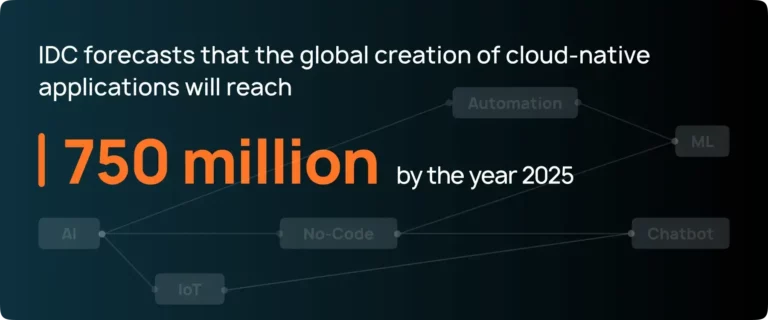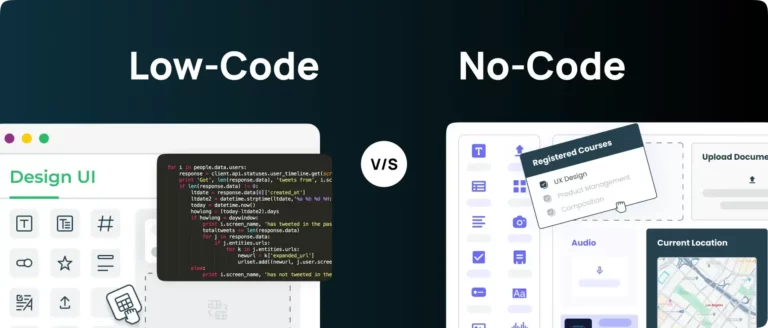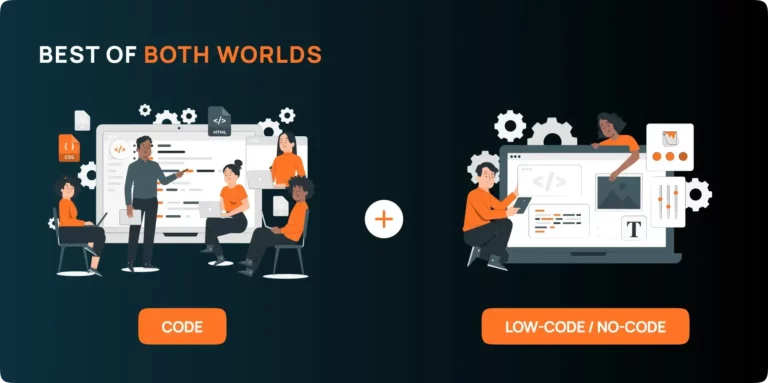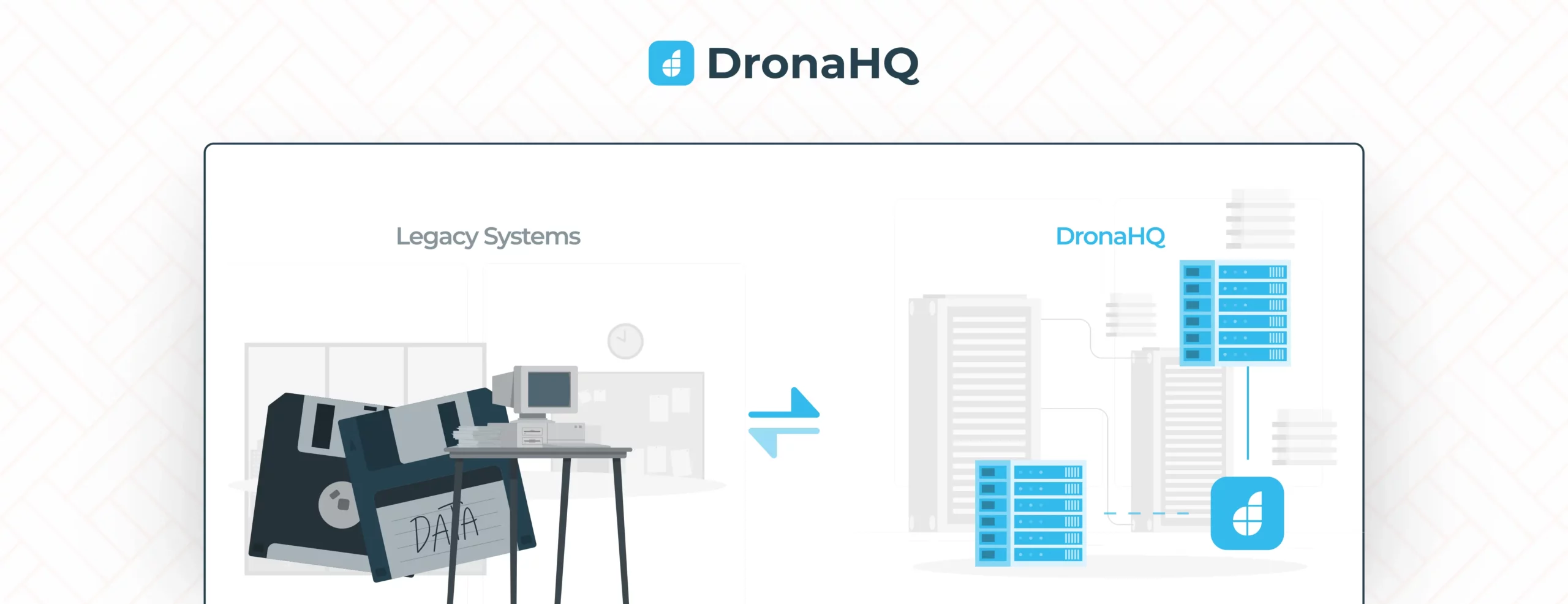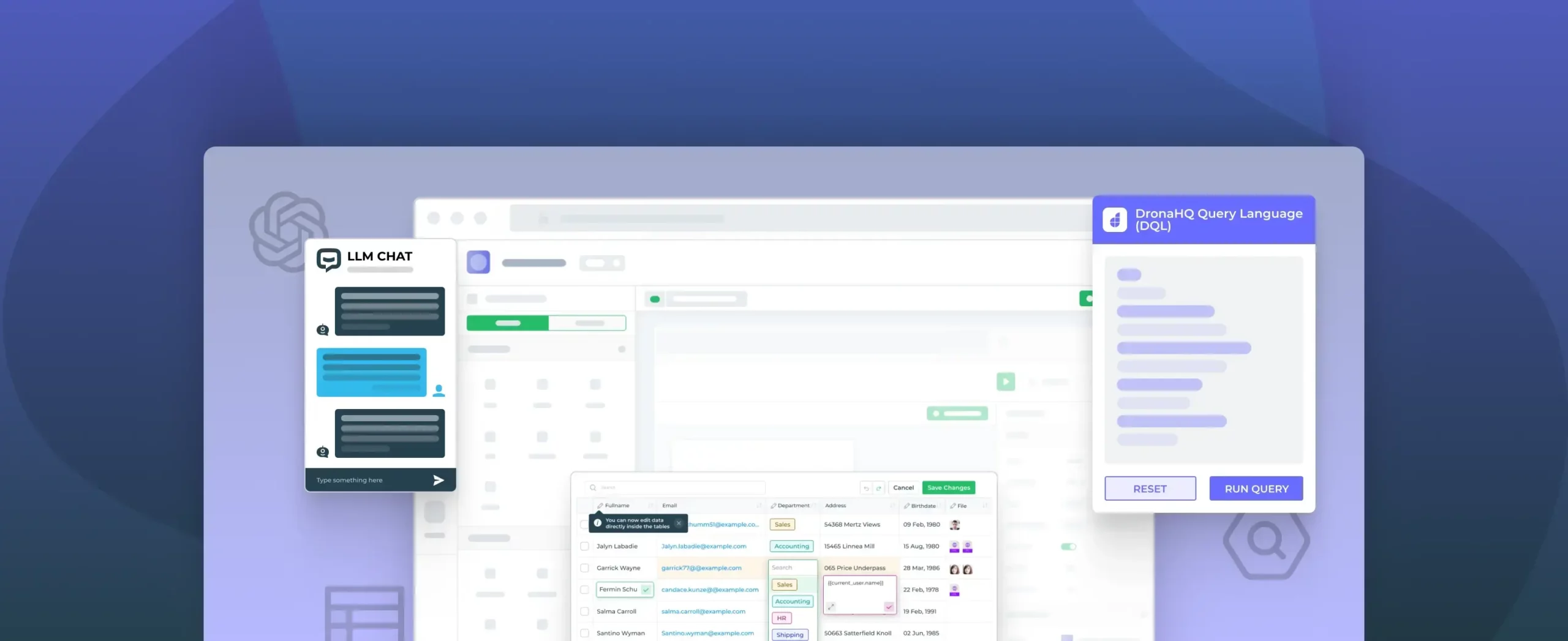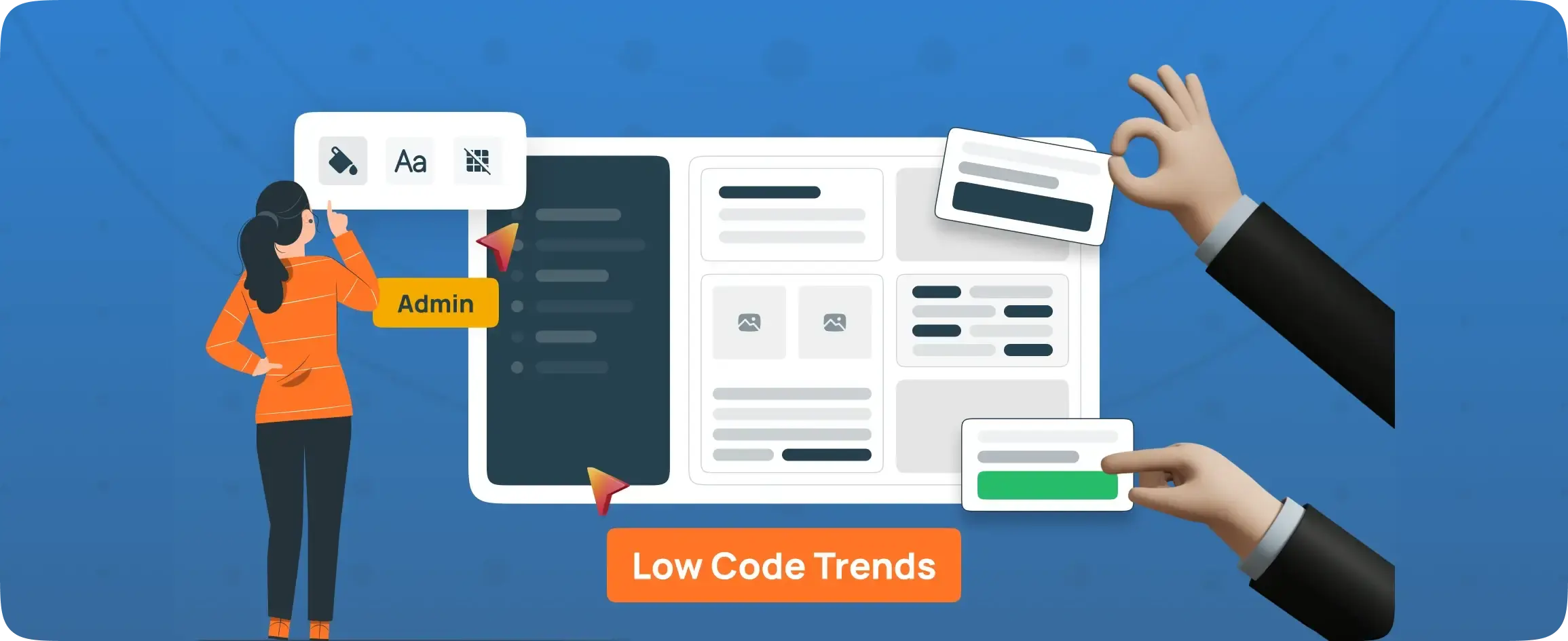
Note these low-code no-code trends for 2024
According to Research and Markets, the low-code no-code market is expected to generate revenue of $187.0 billion by 2030. That’s insane and awesome.
Needless to say, the demand for digital continues to grow. The post-pandemic business landscape has witnessed the most massive shift to digital. IDC forecasts that the global creation of cloud-native applications will reach 750 million by the year 2025. That is much more than decades of apps put together!
To add to that, accessibility to digital tools or no-code or low-code solutions has further reduced the barrier for teams of any shape or size to accelerate implementation – be it the corner retail shop to a custom shirt design e-commerce startup to high growth SMEs to large conglomerates.
Before we dive into the trends driving the low-code no-code market in 2024, let’s review the basics:
What is low-code?
Low-code development is a method of building applications that require minimal manual coding. It utilizes visual interfaces, drag-and-drop functionalities, code templates, and pre-built components to streamline the development process.
| Low-code Pros | Low-code Cons |
| Faster Development: Low-code platforms accelerate the development cycle by eliminating the need for extensive coding, allowing developers to focus on business logic rather than syntax. | Basic Coding Skills Required: While low code reduces the amount of manual coding required, developers still need some level of coding proficiency to utilize advanced features and troubleshoot issues. |
| Increased Productivity: With low code, developers can quickly prototype and iterate on applications, leading to higher productivity and shorter time-to-market. | Cost: Low-code platforms come with subscription fees which can range from user-based to usage-based. Finding the right fit can be tricky in the beginning. |
| Customization: Low-code platforms offer a degree of customization, allowing developers to tailor applications to specific business requirements and user needs. | Complexity: Some low-code platforms may struggle with handling highly complex or specialized applications, limiting their suitability for certain use cases. |
| Easier Maintenance: Applications built with low code are typically easier to maintain and update, as changes can be made quickly through visual interfaces. | Self–hosting: Not all low-code no-code platforms support self-hosting the platform and solutions built. |
Popular low-code platforms include DronaHQ, Zoho Creator, Outsystems, and Mendix. Explore our complete list of top low-code platforms here.
Try the most comprehensive low-code platform DronaHQ with a 30-day free trial.
What is no-code?
No-code adds a layer of abstraction on top of low-code. No-code development refers to the process of building applications without the need for any manual coding. It relies on visual interfaces, drag-and-drop tools, and pre-configured components to enable users without technical backgrounds to create software solutions.
| No-code Pros | No-code Cons |
| Rapid Development: No-code platforms enable users to create applications quickly, often within hours or days, without requiring coding expertise. | Limited Customization: No-code platforms may have limitations in terms of customization and flexibility, particularly for complex or specialized applications. |
| Accessibility: No-code development democratizes app creation by empowering individuals with limited technical skills to participate in the development process. | Integration Challenges: No-code platforms may have limitations when it comes to integrating with external systems or APIs, potentially restricting the functionality of applications. |
| Cost–Effectiveness: No-code platforms are generally more affordable than investing in traditional software development tools, making them accessible to small businesses and startups. | Scalability Concerns: Some no-code platforms may struggle to support large-scale or enterprise-grade applications, limiting their suitability for organizations with complex requirements. |
| User–Friendly: No-code platforms prioritize user experience and simplicity, offering intuitive interfaces and guided workflows that make app creation accessible to non-technical users. | Vendor Reliance: Organizations using no-code platforms are dependent on the platform provider for ongoing support, updates, and maintenance, which can pose risks in the event of service disruptions or vendor changes. |
Popular no-code platforms include names like Zapier, Webflow, and Airtable.
What is the difference between no-code and low-code?
When deciding between no-code and low-code development, organizations must consider their specific requirements, technical proficiency, and long-term goals. No-code platforms excel in simplicity, affordability, and accessibility, making them ideal for startups, small businesses, and non-technical users. On the other hand, low-code platforms offer greater customization, scalability, and control, making them suitable for enterprises, IT professionals, and complex projects. Ultimately, the choice between no-code and low-code development depends on factors such as project complexity, resource availability, and the desired level of coding involvement.
In conclusion, both no-code and low-code development offer valuable tools for modernizing app development processes and empowering a new generation of creators. By understanding the strengths and limitations of each approach, organizations can make informed decisions that drive innovation, efficiency, and success in the digital age.
Low-code no-code tools are industry-agnostic
Low-code and no-code (LCNC) platforms empower users across various industries, from healthcare and education to retail and manufacturing, to create custom applications without the need for extensive coding expertise. For instance, in healthcare, professionals leverage no-code and low-code platforms to develop patient data tracking systems and scheduling applications, enhancing efficiency and patient care. Similarly, in education, these tools enable educators to create interactive learning experiences and educational games without relying on technical skills.
Purplle, for instance, an Indian beauty e-commerce unicorn, uses the low-code platform DronaHQ to supplement administrative operations that control the data that goes on their e-commerce platform and how the visitors interact with it.
SANY, a China-based heavy machinery manufacturer, uses low-code to create IoT-enabled machine tracking apps for SANY equipment owners.
The stationery manufacturer uses low-code to create AI-powered email generators for its lead management workflows.
Top trends to observe in the low-code no-code market in 2024
8. Integration with traditional development
Low-code platforms are increasingly integrating with traditional development practices, bridging the gap between code-centric and visual development approaches.
For instance, platforms like DronaHQ, Retool, and Mendix allow developers to seamlessly incorporate custom code when necessary, enabling greater flexibility and extensibility. This integration empowers organizations to leverage existing code assets while harnessing the speed and efficiency of low-code and no-code development for rapid application delivery.
7. Integration with emerging teach like IoT, AI, and Machine Learning
Another significant trend that we can anticipate in 2024 is the integration of low-code platforms with AI and machine learning. With APIs, making AI accessible to a broader audience, not just AI experts is a game-changer for businesses. Low-code platforms are providing a bridge between engineers and AI integration, simplifying the process of incorporating AI into business systems. For instance, platforms like Microsoft Power Apps are incorporating AI-driven features such as predictive analytics and natural language processing, enabling developers to build intelligent applications without extensive coding expertise. This integration empowers organizations to harness the power of AI to drive innovation and enhance user experiences.
Check our guide on how to build AI-enabled apps in under 10 minutes using DronaHQ and ChatGPT.
6. Integration with DevOps and Agile Methodologies
Integration with DevOps and Agile Methodologies in low-code and no-code platforms is pivotal in 2024. This trend emphasizes aligning development workflows with DevOps pipelines and Agile principles to streamline processes and enhance collaboration. By treating low-code artifacts as first-class citizens in the development lifecycle, organizations ensure seamless deployment alongside traditional code changes, promoting consistency and reliability. Agile methodologies benefit from rapid prototyping and real-time collaboration features of low-code platforms, enabling quick adaptation to changing requirements. Furthermore, automation tools extend to low-code development, enhancing efficiency and quality while accelerating innovation. This integration fosters a culture of automation and continuous improvement, allowing teams to deliver value to customers faster and more reliably.
Ultimately, aligning low-code development with DevOps and Agile practices empowers organizations to optimize their development processes and deliver high-quality applications efficiently.
5. Integration with Data Analytics and BI Tools
Integrating low-code and no-code platforms with data analytics and business intelligence (BI) tools is gaining momentum as organizations recognize the value of deriving insights from their data. By seamlessly integrating these platforms, businesses can empower users to create data-driven applications and dashboards without extensive coding knowledge. For instance, some low-code platforms allow users to connect to various data sources, including BI tools like Power BI, enabling them to visualize and analyze data in real time. Similarly, no-code platforms like Airtable offer built-in integrations with popular BI tools, facilitating the creation of dynamic reports and analytics dashboards. This trend not only enhances decision-making capabilities but also democratizes data access across the organization, enabling stakeholders at all levels to leverage insights for better business outcomes. As organizations continue to prioritize data-driven strategies, the integration of low-code and no-code platforms with data analytics and BI tools will play a crucial role in driving innovation and competitiveness.
4. Legacy systems get revamped
The urgency to revamp legacy systems using low-code and no-code platforms is underscored by the pressing need for organizations to modernize their outdated infrastructure. Currently, 72% of IT leaders state that their ticket backlog interferes with strategic projects. They spend much of their time maintaining legacy systems. Main reasons businesses use low-code according to research from OutSystems, “Reduce or Avoid Legacy Debt” ranks third among the main reasons businesses turn to low-code solutions.
These statistics underscore the critical role of low-code and no-code platforms in addressing the challenges posed by legacy systems. By leveraging these platforms, organizations can incrementally migrate functionality from legacy systems to modern, cloud-native applications, minimizing disruption to ongoing operations.
Low-code platforms like DronaHQ enable businesses to rapidly build and deploy replacement applications for legacy systems, facilitating seamless integration with existing infrastructure. As organizations prioritize digital transformation initiatives, the adoption of low-code and no-code platforms for revamping legacy systems will continue to gain momentum, driving innovation and competitiveness in the evolving business landscape.
Read: Legacy application modernization using low-code platforms
3. Citizen developers will create more applications
By 2024, 75% of enterprises will use at least four low-code platforms for citizen development initiatives and business application development. Gartner states that by 2023, there will be 4x more citizen developers than professional developers at large enterprises.
2. Expansion to Complex Applications
Traditionally, low-code platforms have been associated with the development of simple applications. We can expect low-code platforms to expand their capabilities to handle more complex applications. Picture this: A couple of years back low code or no-code platforms could help you roll out apps for data collection, approval systems, dashboards, and reporting. Refined functionality and improved capabilities now support the development of comprehensive solutions like CRM extensions, HRMS tools, AI-enabled apps that cut down work by 10x, and more!
As the demand for sophisticated applications grows, low-code platforms are evolving to accommodate the development of intricate, enterprise-grade solutions. This expansion will enable organizations to leverage the benefits of low-code development across a wider range of projects.
1. Increased Adoption
The adoption of low-code platforms is expected to soar. Businesses across various industries are recognizing the benefits of leveraging low-code platforms to develop applications quickly and efficiently.
At its current rate, 70% of new business applications will use low-code/no-code technologies by 2025. By 2024, 80% of non-IT professionals will develop IT products and services, with over 65% using low-code/no-code tools.
KPMG suggests that about 60% of the company managers surveyed rate low-code development as “critical to very critical” for the further performance of their companies, both from an operational and a strategic point of view.
With the rising demand for digital transformation, organizations are seeking ways to build applications rapidly and optimize available resources. Low-code platforms provide an ideal solution to this challenge, enabling businesses to streamline their development processes and accelerate time-to-market.
Remember, the key to success lies not only in adopting these trends but also in selecting the right low-code platform that aligns with your specific business needs and objectives.
Check our 9-step guide to choose the right low-code platform
How DronaHQ can revolutionize your app development process
DronaHQ’s low-code platform makes app development more accessible and streamlined. Here’s how DronaHQ can revolutionize your app development processes.
- Scalability and Security
DronaHQ is designed to cater to the needs of businesses of all sizes. Whether you’re a small startup or an enterprise-level organization, DronaHQ can scale to meet your requirements. Its scalable architecture ensures that your apps can handle increasing user loads and growing data volumes without compromising performance. Additionally, DronaHQ prioritizes the security of your data. With self-hosting options, your sensitive information remains within your servers, providing an extra layer of protection.
2. Frontend actions for enhanced user interactions
With DronaHQ, developers have access to a wide range of front-end actions that can enhance user interactions. By simply dragging and dropping action blocks, developers can validate screens, fire queries into databases, call APIs, generate PDFs, send emails, show toasts, navigate to screens, refresh data, and perform over 100 other actions. These actions can be triggered by events like screen openings or button clicks, allowing you to create dynamic and interactive app experiences.
3. Data integration makes simple
DronaHQ simplifies the process of integrating data from various sources. Whether you need to connect to databases, APIs, or other third-party apps, DronaHQ provides a seamless solution. Your data never leaves your servers, ensuring the highest level of security and compliance. Developers can query and bind all their data sources on demand, enabling real-time data updates and ensuring that your apps are always up to date with the latest information.
4. Mobile app development made easy
Having a mobile app is essential for reaching a wider audience. DronaHQ understands this need and automatically converts your apps into both web and mobile applications. This allows users to access your apps seamlessly across different devices, ensuring a consistent user experience. By leveraging DronaHQ’s platform, you can develop highly secure and fully functional mobile apps without the need for building apps from scratch for different devices or OSes.
5. Troubleshooting and detailed app building
DronaHQ offers a range of tools and features to simplify troubleshooting and enhance the app-building process. Developers can add watchlists, breakpoints, view states, timelines, and connector logs to troubleshoot and build apps with great detail and precision. These features enable you to track approval requests, monitor complex workflows, and gain deeper insights into your app’s performance. By leveraging these tools, you can ensure that your apps are robust, efficient, and free from any bugs or issues.
6. Multiple pricing plans
DronaHQ offers a variety of pricing plans to accommodate different business use cases. Whether you’re a small startup, a growing SME, or a large enterprise, DronaHQ has pricing options that suit your requirements. These plans include user-based pricing, usage-based pricing, and developer-only licenses, providing flexibility and scalability to businesses of all sizes. With multiple pricing plans, organizations can choose the option that best aligns with their application requirements, ensuring cost-effectiveness and maximizing ROI. Whether you need a solution for a specific project or comprehensive app development across your organization, DronaHQ’s pricing plans cater to diverse needs.
7. Unparalleled support
DronaHQ provides a comprehensive support ecosystem to assist users at every stage of their app development journey. This includes extensive documentation, tutorials, and live chat options, ensuring that users have access to resources and assistance whenever they need it. With round-the-clock engineering assistance available 24/7, DronaHQ’s dedicated engineering support team is readily available to assist you. Whether you encounter technical issues, require guidance on platform features, or need help with troubleshooting.
In conclusion, DronaHQ is a powerful low-code platform that can revolutionize your app development process. With its drag-and-drop interface, seamless integrations, customizable components, and extensive features, DronaHQ empowers developers to create innovative and efficient apps. Its scalability, security, and mobile app development capabilities make it an ideal choice for businesses of all sizes. By leveraging DronaHQ’s advanced features and tools, you can streamline your app development process, save time, and deliver high-quality apps that meet the needs of your users.
FAQ’s
Why choose a low-code platform?
Traditional software development methods can be time-consuming and cumbersome, often leading to delays in delivering solutions to the market. This is where low-code platforms come into play. Some reasons to adopt low-code are:
- Accelerating time to market
In today’s fast-paced business environment, time to market is a critical factor for success. Businesses that can bring their products and services to market faster gain a significant competitive advantage. Low-code platforms play a pivotal role in accelerating time to market by enabling rapid application development.
With traditional development methods, building complex applications from scratch can take months or even years. Low-code platforms, on the other hand, provide a framework that allows developers to quickly assemble applications using pre-built components. This significantly reduces the development time and enables businesses to launch their products or services much faster.
- Higher productivity
One of the key advantages of low-code platforms is their ability to boost productivity. Traditional software development processes can be complex and time-consuming, requiring developers to write extensive lines of code. This not only slows down the development process but also increases the chances of introducing errors and bugs.
IDC found that low-code spread up the software development lifecycle by 62% for new applications and 72% for adding new features, achieved an additional $19.8 million in annual revenue, and increased productivity by 123%.
This eliminates the need for manual coding, significantly reducing the time and effort required to develop an application. Developers have access to out-of-box functionality, requiring them to only code for custom enhancements, if any.
- Effective risk management and governance
When it comes to software development, risk management, and governance are crucial aspects that organizations cannot afford to overlook. Traditional development methods often lack the necessary checks and balances, which can lead to security vulnerabilities, compliance issues, and other risks.
Low-code platforms provide a structured development environment that promotes effective risk management and governance. These platforms often come with built-in security measures, such as authentication and authorization mechanisms, to ensure that applications are developed with security in mind. Additionally, low-code platforms often adhere to industry best practices and compliance standards, reducing the risk of non-compliance.
By choosing a low-code platform, organizations can build applications that are secure, compliant, and reliable. This not only reduces the risk of security breaches and downtime but also instills confidence in customers and stakeholders.

